Christina MacRae: For my editorship I am taking the theme of documentation as a focus of discussion and practice sharing. As both a researcher and as an artist, documenting my work in the form of sketchbooks and journals is an important practice. It allows me to return to events, ideas, and objects for ongoing re-interpretation. I work collaboratively in schools and early years settings and at the moment I am experimenting with ways of opening my documentation out in order to make it a more shared, conversational and dialogic tool, instead of one mainly concerned with my own thinking. I would like to find out how other researchers, artists and teachers use documentation to as a space for reflection and for creative action. As part of my editorship I have been asked to include work that highlights practice in particular projects. For this, rather than focussing on the project itself I want to look specifically at the practice of documentation. I would like to look at a variety of examples of ways that artists have documented their projects. I am inviting artists who work in schools/early years settings to scan in a piece of documentation (a page from a sketchbook, or a learning journey, or a journal, or whatever form your documentation may take) and then with this image attach up to 200 words on why documentation is important to them as practitioners.
Actions of Listening: Pedagogical Documentation
Artist: Debi Keyte-Hartland
For me, pedagogical documentation is a process of collecting and collating visible traces (e.g. photographs, video, audio, transcripts of dialogue, artefacts) of children’s processes of learning. These collated traces are used as visible/audible ‘rememberings’ and the subsequent analysis and interpretation of these traces can then be used to re-present to a wider audience to gather their perspectives of learning processes and the construction of knowledge of the individual or group of children. Pedagogical documentation requires time and energy to be given for reflection and analysis of children’s engagement and the preparation of materials that convey what has been understood. Carla Rinaldi (2006) uses the term of research to describe this process that makes visible the perspectives and interpretations of pedagogical work: visualising the learning of children. Your knowledge as documenter is neither fixed nor complete, but constantly evolving and re-elaborating with each new observed encounter.
A complexity of pedagogical documentation that I struggle with constantly is the pressure to try to fit it (and the learning it reveals) to generalised and externally set phases of development and curriculum. I agree with Dahlberg, Moss & Pence (2007, p.146) that pedagogical documentation should not be confused with child observations, the focus of which they say, "are a technology of normalization, related to constructions of the child as nature and as reproducer of knowledge". Similarly, for Rinaldi (2006), pedagogical documentation adopts a more postmodern perspective that neither claims nor aims to capture any true objective within any set of standards. It means letting go of looking for something fixed and expected and instead embraces practices of uncertainty. I use documentation as a process to try to understand how children think and construct meaning rather than establishing what they and I already know and understand. Pedagogical documentation is a more powerful tool when everybody is involved in its construction and interpretation. I have found, working as an artist that I have practical skills to share with early years educators about taking process based photography, visualising learning in panels or small publications and visual ideas about using journals. Also, as someone with a background in the arts and not education I have another point of view to offer. However, if I was to be the sole documenter and did not seek to share the interpretation of these traces then what I re-presented to others would only ever be partial, a singular and narrow point of view. Through being in dialogue with others who are also documenting and sharing their traces for shared interpretation, multiple voices inform the reading of the material. This shared reflective dialogue enables a deepening of everybody’s learning about how our pedagogical practices and actions affect the children’s learning. We learn about ourselves and not just about the children and thus pedagogical documentation becomes a form of continual professional development that helps us to get better at being alongside of young children. The majority of my work now as an artist working in education is about enabling whole teams to come together, to document, to share the traces, to collectively interpret and make visible our mutual understandings of how children learn and make sense of the world.
References: Dahlberg, G. Moss, P & Pence, A. (2007) Beyond Quality in Early Childhood Education and Care: Languages of Evaluation. 2nd Ed. London: Routledge; Rinaldi, C. (2006) In Dialogue with Reggio Emilia: Listening, researching and learning. Oxon: Routledge.
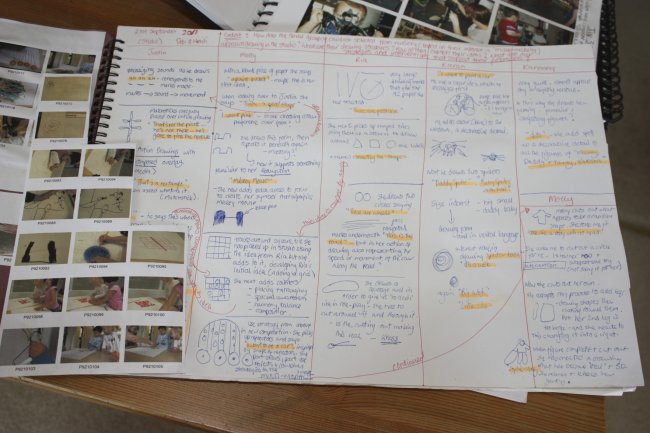
Journal Page. I usually work with a grid format, clearly stating the obvious signs (date, who was involved etc) but also stating the context, which was in this case observing how the small group of 3-4 year olds approached mixed media drawing. I write my intentions, which were to ‘capture their drawing strategies to begin to find out how they are expressing ideas about composition’. After the session I highlight significant dialogue, actions and gestures and print off thumbnail photographs that relate to my notes. I may add questions and reflections of my own. The traces are then taken to a daily reflection meeting for group discussion and further reflective notes added to. Over time, the notes and photographs in the journal build up quickly over time and are then used to track where ideas have started, changed or developed.
Artist: James Aldridge, ’What Might We See On Our Walk?’
(http://www.creative-ecology.co.uk; http://www.5x5x5creativity.org.uk; http://www.pittonpreschool.com)
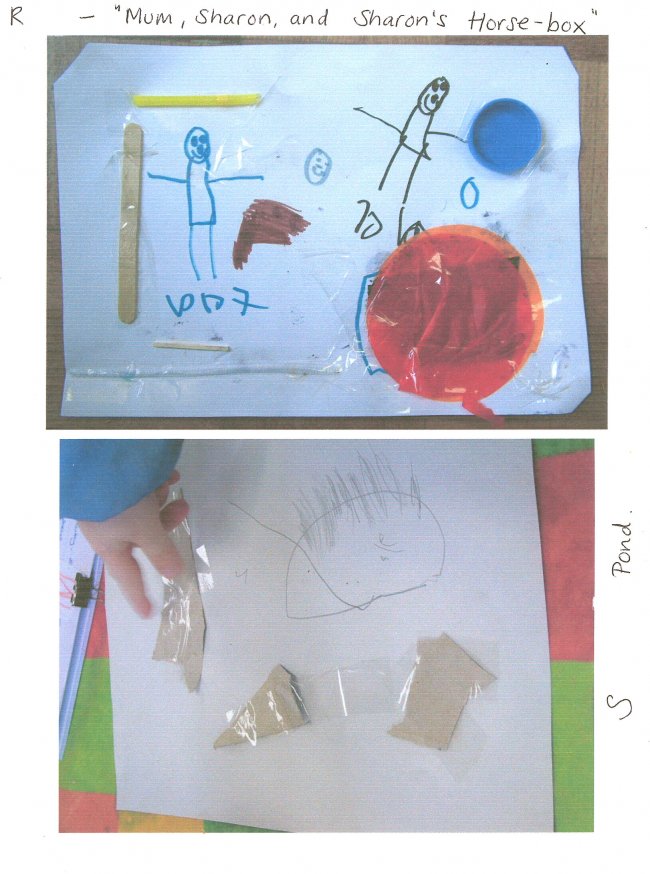
I worked as an artist with Pitton Pre-School, near Salisbury from 2004 until 2007, carrying out three action research projects through 5x5x5=creativity. This is a page from ‘The Blue Book’, into which photographs, drawings and other visual documentation of our sessions were placed during each year’s project. The documentation supported a collaborative approach to working with staff and children, by enabling the children to remember past sessions and plan new ones with us. At this stage of the project we’d had six weekly sessions together. Children had been on one walk, collecting ‘treasures’ along the way, and using still and video cameras to document it for themselves. In this session we are planning a new walk, asking them to think about what they might see, looking at maps of the area, and providing them with sticking and mark-making materials.
R - puts an orange circle over the top of the horse - "That’s the flame of him - you can see him in there." (Lighting up the horse?)
R - "Can you take a photo of mine and put it in the book?"
James - "That’s a good idea, do you want to tell me anything else about it to write down?"
R - "Yes, do you know what that is? It’s Sharon’s horse box."
J - "She has bits above, to the side and below her."
R - "That’s the roof of the horse box, that’s the side bit... and that’s the side bit." (R has coloured her fingerprints to become the horsebox)
Artist: Claire Witcomb
Carlito and Enzo
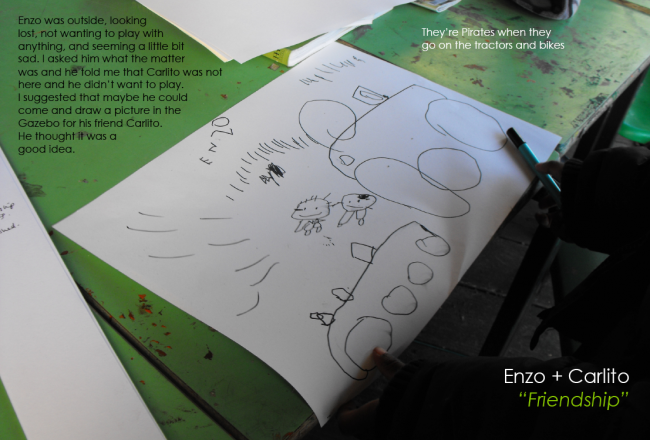
As an artist I find there’s always the need to ask questions about ourselves, the world and life. The ability to ask questions and foster a curiosity for the world we live in is what makes us human. Documentation for me takes many different forms. Collecting words and images, making drawings all acts as an aide memoir. It’s all about observing. These collections can act as a trigger and means of re-visiting and re-looking and re-thinking events and moments. Time is another huge factor as I find I need to let things filter through, to give myself space to formulate and reflect . Documentation can be a great many things - but most of all in working with young children it’s a way of sharing, understanding, celebrating, and challenging the achievements of children.
The page that I have attached is a little piece of ’finished’ (ie. it went into his learning journey book) documentation that I did after I verbally supported a little boy ( 3yrs ) to draw a picture for his friend. They had a very strong friendship and his friend was ill that day and he was missing him...
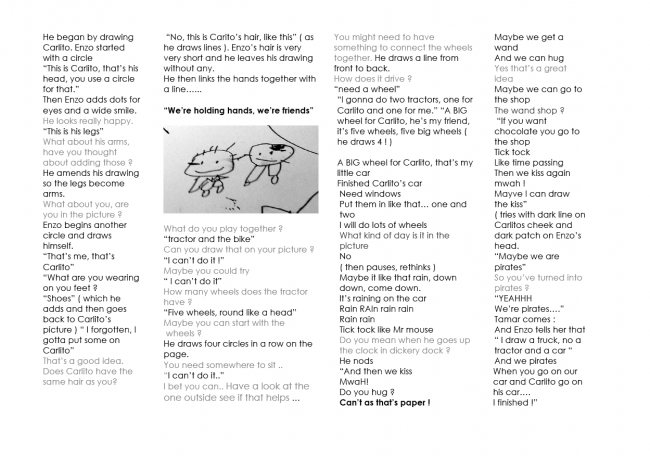
Artist: Lorna Rose (http://lornarose.co.uk/)
Artist-in-residence, Lillian De Lissa Nursery School, Birmingham
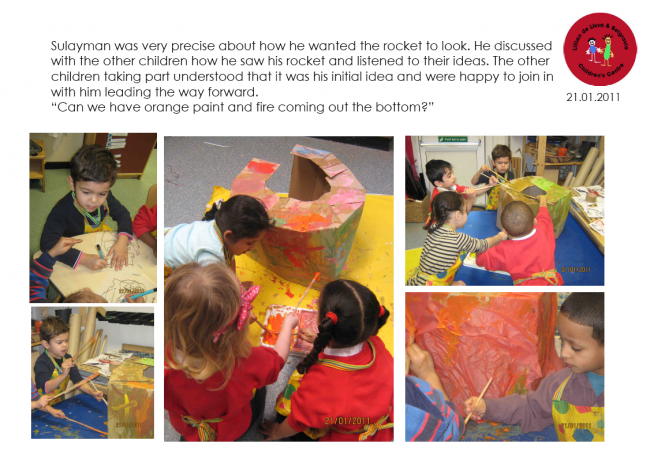
At Lillian de Lissa Nursery School we have developed a wide knowledge and appreciation of the teaching and learning styles, of both practitioners and children. We recognise that children respond differently to practitioners, provocation and environments, and we use documentation to evidence each child’s learning interactions taking place. I work in school for 3 days a week and have built a strong relationship of communication and understanding with the staff team by providing another way of finding out about the children and how they like to learn. My documentation shows the exchanges of knowledge, interests and actions between the children whilst working creatively with a wide range of stimulus and everyday objects including art materials.
The documentation I create is displayed in school and shared with all staff members so extensions of learning can be considered, discussed and put in place. This visual documentation is also used for reflection by the children and family members. Our cycle of reflective practice moves through action, documentation, observation, interpretation, action. In this way, short term planning is based around the findings that have been recorded. These pieces of documentation show only a fraction of one child’s investigation into understanding maps and as well as demonstarting social skills.
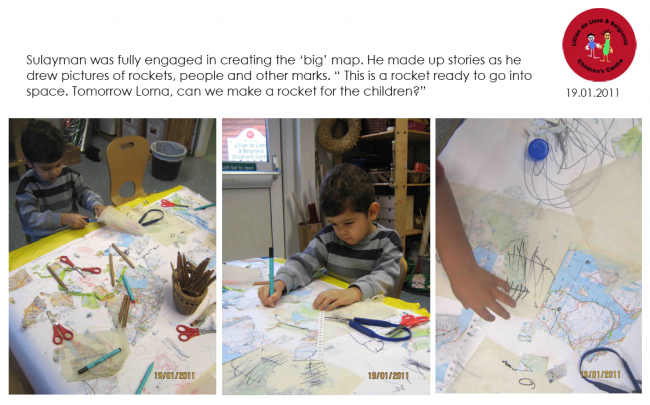
Artists: Tumim and Prendergast (http://www.axisweb.org/seCVPG.aspx?ARTISTID=12154)
Scrapbooks from a residency in the Royal Aberdeen Children’s Hospital
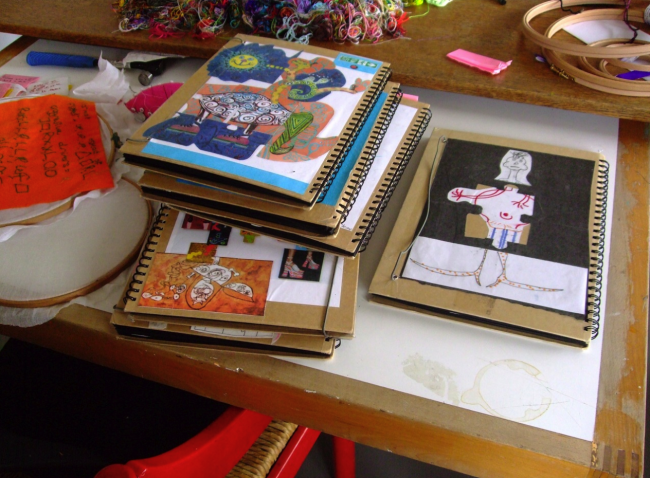
Tumim and Prendergast is a research-led, collaborative between Orkney based artists Matilda Tumim and Christopher Prendergast who use many different forms to explore their ideas - but embroidery is currently their main medium of choice. Much of their work is concerned with loss. They are interested in items that have been lost or discarded, of lost loved ones and of people who lose their way literally and emotionally and also the loss of dignity, lost youth and the loss of innocence and nature’s discarded remnants.
These scrapbooks come from a project with Glaitness School on Orkney and staff and patients of the Royal Aberdeen’s Children’s Hospital to create new work for the lift lobby ( http://www.rach-art.org.uk/Tumimandprendergast.htm ). The scrapbooks feed directly into the work that the artists produce.
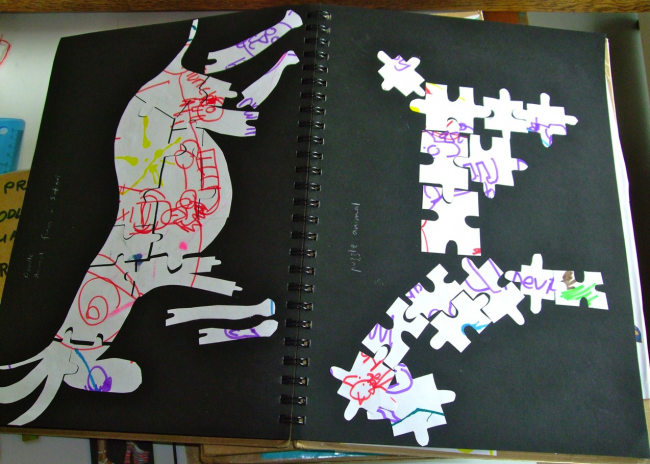


No comments added